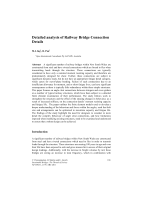Bridges

- Publication no: ABC-AAI004-11
- Published: 31 October 2011
- PDF (free) Download
A significant number of railway bridges within New South Wales are constructed from steel and have riveted connections which are forced to flex when transmitting loads through the structure. These connections are typically considered to have only a nominal moment resisting capacity and therefore are predominately designed for shear. Further, these connections are subject to significant dynamic loads, but do not have an appropriate fatigue detail category, which caters for out-of-plane bending. Failure of such connections due to an insufficient allowance for moment, and or short fatigue lives, can have significant consequences as there is typically little redundancy within these simple structures. This paper focuses on angle cleat connections between stringers and cross girders on a number of typical railway structures, which have been subject to a detailed finite element examination of their performance. The study follows work to strengthen the structures and the effect of the ensuing changes in behaviour, as a result of increased stiffness, on the connection details’ moment resisting capacity and fatigue life. The paper outlines the finite element models used to develop a deeper understanding of the behaviour and forces within the angles, such that bolt size and arrangements can be optimized to maximize capacity and fatigue life. The findings of the study highlight the need for designers to consider in more detail the complex behaviour of angle cleat connections, and how limitations imposed when modifying existing structures, need to be examined and understood to ensure that a robust design can be achieved.
